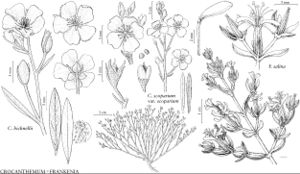Frankenia
Sp. Pl. 1: 331. 1753.
Gen. Pl. ed. 5, 154. 1754.
| Taxon | Illustrator ⠉ | |
|---|---|---|
 | Crocanthemum bicknellii Crocanthemum scoparium var. scoparium Frankenia salina | John Myers John Myers Linny Heagy |
Branches articulated, often swollen at nodes, usually differentiated into long and short-shoots, hairs simple. Leaves petiolate or sessile, salt crystals usually present on leaf surfaces, sometimes forming solid crust, short-shoot leaves in axillary fascicles; petiole sometimes inconspicuous, narrow to broad distally, margins usually ciliate. Inflorescences: floral bracts leaflike, usually connate basally into verticels of 4, clasping calyx base (rarely adnate to calyx base). Flowers: calyx-tube cylindric [campanulate], strongly rounded-ribbed; 4–6 [–7] -lobed, petals white, pink, violet, or blue-purple, oblong-oblanceolate to spatulate, claw linear, broadening slightly at apex, to narrowly cuneate, limb apex truncate or rounded, erose-denticulate to sinuous, glabrous; anthers yellow or red to yellowish pink to purplish red; ovary with [1–] 2–60 [–100] ovules, funiculi ascending and bearing erect ovules or deflexed and bearing pendulous ovules, usually free, infrequently adnate to carpel wall for part of their lengths. Seeds ivory to golden brown, ovoid-conic or elongate-ovoid to oblong or ovoid-ellipsoid or ellipsoid. x = 5.
Distribution
United States, Mexico, South America, Eurasia, Africa, Atlantic Islands, Australia, in West Indies
Discussion
Frankenia species vary in the degree of revoluteness of the leaf margins. This is most easily determined on fresh or softened material; loosely revolute margins will often tend to become somewhat more revolute on drying but can still be distinguished from tightly revolute margins that are not readily unrolled.
Species ca. 70 (5 in the flora).
Selected References
None.
Lower Taxa
Key
| 1 | Leaf blades subterete, margins tightly revolute, abaxial surface mostly concealed | > 2 |
| 1 | At least some leaf blades flat, margins slightly to loosely revolute, abaxial surface mostly exposed | > 3 |
| 2 | Styles (2–)3(–4)-branched; petioles sometimes absent, 0.1–1.5 mm, apex ± similar in width to base of blade. | Frankenia jamesii |
| 2 | Styles 2(–3)-branched; petioles (0.2–)0.3–1 mm, apex abruptly and markedly wider than base of blade. | Frankenia palmeri |
| 3 | Herbs, annual; petals 2.5–5.2 mm; seeds 0.4–0.7 mm. | Frankenia pulverulenta |
| 3 | Subshrubs, or shrubs, perennial; petals 5.5–11.5 mm; seeds 0.8–3.1 mm | > 4 |
| 4 | Branches hairy, hairs appressed; petiole subcylindric and narrow distally, tapering markedly toward blade; seeds 2–3.1 mm. | Frankenia johnstonii |
| 4 | Branches glabrous or puberulous or short-pilose, hairs erect or suberect; petioles not markedly tapering toward blade; seeds 0.8–1.5 mm. | Frankenia salina |
"narrow" is not a number.